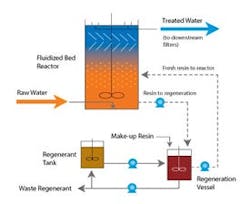| Related Searches from WaterInfoLink.com Total Organic Carbon | Orica Watercare, Inc. | Stage 1 DBP Rule | State Revolving Fund |
Yankeetown is a town on the northwest coast of Florida with a population of around 650. The drinking water supply, sourced from local wells, contained total organic carbon (TOC) that was reacting with chlorine during disinfection, resulting in the formation of disinfection byproducts (DBPs) in the distribution system that exceeded the U.S. Environmental Protection Agency's (EPA) Stage 1 DBP Rule.
In 2005, the town engaged consulting firm Mittauer & Associates to help determine how to bring the water supply into compliance with the new EPA DBP standards for total trihalomethanes (TTHM) and five haloacetic acids (HAA5). Additionally, the town wanted to improve the aesthetic quality of the water by reducing color and TDS while improving taste and odor.
A large percentage of the TOC in potable water sources is polar (negatively charged). Therefore, it can be removed by exchanging a chloride ion on the surface of an anion exchange resin for polar organic material. The resin can then be easily regenerated with sodium chloride solution.
The fluidized bed reactor is not impacted by solids in the raw water feed and therefore does not require any pretreatment. The continual regeneration of resin in brine also minimizes any biological growth within the ion exchange process.
A pilot study was conducted at the Yankeetown water plant in 2006 and showed a 60% reduction in TOC with the MIEX process . As a result, simulated distribution system TTHM and HAA5 levels could be reduced by over 70% and 85% respectively, well within the EPA standards.
Mittauer & Associates recommended the installation of the process to provide DBP compliance. A reverse osmosis (RO) system was also included in the design to treat up to 15% of the MIEX-treated water to reduce the overall treated water TDS level. These recommendations were submitted in an application to the Florida Department of Environmental Protection (DEP) for a state revolving fund (SRF) grant/loan, which was subsequently approved in late 2007.
The new water plant was constructed during 2008 and commissioned in January 2009. The treatment train consists of pretreatment using the process (300 gal-per-minute packaged MagnaPak system) followed by multimedia filtration. After filtration, 85% of the filtered water goes to a clear water storage while up to 15% passes through the RO system for TDS reduction before blending back in the storage.
After start-up, the first set of EPA compliance samples taken in March 2009 showed that TTHM and HAA5 levels had been reduced to 58 µg/L and 22 µg/L respectively, comfortably below the EPA limits of 80 µg/L and 60 µg/L. In comparison, prior to start-up of the new plant the running annual averages over four quarters for TTHM and HAA5 levels were 179.3 µg/L and 91.6 µg/L respectively.
“The MIEX system has brought our water back within the EPA DEP water quality standards and allowed us to achieve these results while reducing the needed land for disposal of waste compared to other systems,” said Dawn Marie Clary, Yankeetown’s mayor. “I have also received comments from the citizenry that the water has an improved taste and clarity."
The Yankeetown Water Plant is the sixth MIEX system installed in Florida to reduce DBP levels and color related to organic carbon. Five additional Florida systems are currently in various stages of design or construction.
